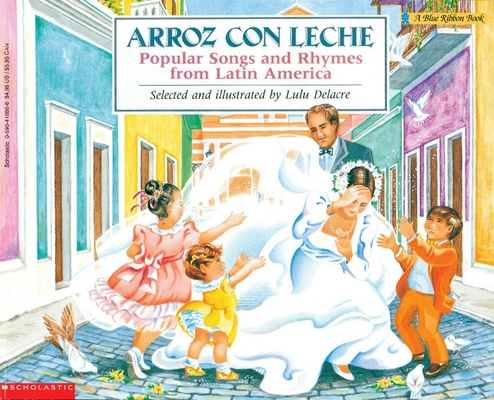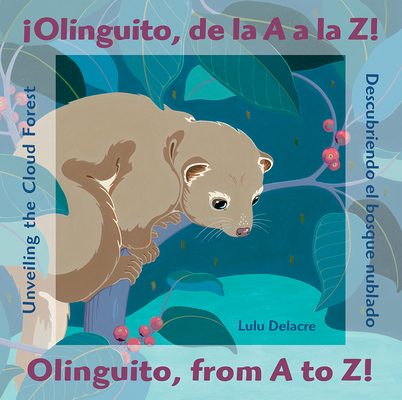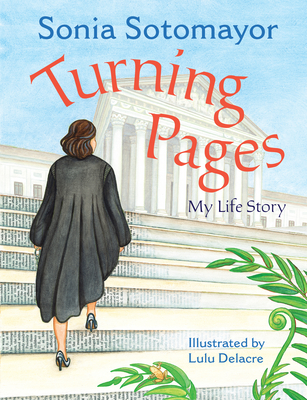By Cecilia Cackley

“I’ve decided that this is going to be my best decade!” declares Lulu Delacre. She has just turned sixty and after thirty-eight years in the publishing industry, she has written or illustrated over thirty different books for young readers, making her one of the most prolific Latinx artists working today. Her latest book, Turning Pages is an autobiographical picture book by Supreme Court justice Sonia Sotomayor and arguably Delacre’s highest profile collaboration to date.

Delacre was born in Puerto Rico to Argentine parents who encouraged her love of drawing. After beginning her college career in the Fine Arts department of the University of Puerto Rico, she transferred to L’Ecole Supérieure d’Arts Graphiques in Paris, France. Delacre says she was inspired to apply for the school after learning that a famous Puerto Rican artist had trained there. Her father was skeptical, telling her she wouldn’t get in because of the quality of work required, but she was accepted into the third year of the five year program and eventually received a full scholarship to finish her degree after her family ran into financial hardship. Delacre studied many different artistic disciplines at the school, including typography and print-making, and the course included real-world assignments such as designing a new currency that she remembers as challenging and fun. Some of the more traditional European assignments had amusing results for a student from the Caribbean, she says.
“[For] one of my first assignments we had to illustrate the four seasons, and of course, I was coming from Puerto Rico. So, winter—I did something in pastel pinks and blues and everyone laughed, but of course it was a matter of perspective! I came from an island, I had never witnessed winter before, never in my life.”
Delacre says that she had no idea at that point that you could become a children’s book illustrator. “Books that we got in Puerto Rico were mostly fairy tales from Spain, which didn’t speak to me. The concept of the picture book was entirely foreign to me.” She discovered picture book illustration at an American gallery in Paris which was showing art from the book In the Night Kitchen by Maurice Sendak. “That was a revelation. I had no idea before that moment what I wanted to do.” Delacre had been focusing on graphic arts because she wanted to earn a living and recognized, “I was not at the level of a Picasso,” but now she had found the work that would become her passion.
After finishing school, Delacre moved to San Francisco with her husband, who was in the military. She had no contacts, but started knocking on doors and found work doing textbook illustrations and commercial artwork. When her family moved to Massachusetts, she started giving to the children’s section of the public library and taught herself to create picture books by analyzing examples such as Where the Wild Things Are. With no connections in publishing, Delacre had to hustle to break into the industry.
“In order to get into the field, I went to New York. I created two identical portfolios and made twenty-two appointments in five days, stayed at the Y, and by that Friday, I had my first job illustrating for Sesame Street magazine. From there, [I moved to] Simon & Schuster when they had Little Simon. I started illustrating public domain material like these [nursery rhyme] board books.”

Delacre’s first book to incorporate Latinx culture was inspired by the birth of her daughters, to whom she wanted to introduce to traditional Latin American children’s rhymes. “I went to the library looking for a book of our folklore, from Latin America, our nursery rhymes, and I couldn’t find anything. Why do American kids get to have these books and kids that come from Spanish speaking countries don’t?” Delacre had recently published the Nathan and Nicholas Alexander books with Scholastic, so she went to her editor there and suggested the book of songs and rhymes that eventually became Arroz con leche, which turns thirty this year and is still in print.
Delacre’s first books with Simon and Scholastic were done in colored pencils, over a thin layer of watercolor to make the process go a little faster. In her home studio in Maryland, she has two large art tables surrounded by materials, including colored pencils, acrylics, watercolors and collage materials. “I do everything the old-fashioned way,” she says. “I like to touch materials. I try to do things that the computers cannot do yet. That’s why I use collage and the textures, pressed leaves—things that the computer doesn’t do or doesn’t do as well.”

Delacre pushes herself to try new art styles and materials for each project she takes on. Salsa Stories has linoleum cuts because the stories are being told by characters who would have been familiar with that style of art in Puerto Rico in the 1950’s. Her book US in Progress pairs short stories with illustrations created from collaged newspaper, pencil drawings on acetate and texture created from tiny holes in rice paper. Olinguito A to Z, a Spanish alphabet book, was based on scientific information about the different animals who live in the Ecuadorian cloud forest. The different species were painted in flat colors, a graphic version of each animal that reaches back to Delacre’s work as a graphic designer. The background paper for each spread was created from actual leaves from the cloud forest. She also created the typography for the letters that appear on each page. “I created the letters because I wanted them to fit in a square to mirror the shape of the book. I wanted to show the kids what the mist looked like. In the cloud forest, you would see everything through the mist, so to reveal the true colors of the species, I gathered the mist in the squares surrounding the letters.”

Delacre’s most exciting recent project is the picture book autobiography Turning Pages by United States Supreme Court Justice Sonia Sotomayor. She explains that the process of getting the assignment was a bit unusual. “I got an email from [editor] Jill Santopolo asking if I had an agent, and I said not any more, and so she goes, “I need to talk to you, can I call you tomorrow?” and I said sure and gave her my number. I get a call the next day and she begins by saying, “I have a somewhat secret project that needs to be fast tracked and we want you for it.” And then she explains about the project and I pause, it’s sinking in and I said “Why me?” I had never worked for this publisher, and I had never worked with her. And she answers, “’Because she chose you,’ meaning the justice. This is very rare—this is the very first time that the author handpicks me.” Delacre goes on to explain that Sotomayor was given a stack of picture books to look at when selecting an illustrator and that one of the reasons she chose Delacre was because the justice wanted the illustrations to be lifelike. “I know that one thing that was very important to her was to portray her mamá and her abuelita as close as possible to reality.” Sotomayor also appreciated that Delacre has a strong relationship with the island of Puerto Rico. Although the book mostly takes place in urban settings such as the Bronx, Delacre began each oil wash with a layer of green sap oil, because Sotomayor wanted the island to be present in the illustrations. The original artwork from Turning Pages can be seen in the Zimmerli Art Museum at Rutgers University through March 17, 2019.

Delacre says that her advice to Latinx illustrators trying to break into publishing is “Follow your heart. Tell the story that you really have within you and you really must tell. Don’t feel like you have to be like someone else. Just be yourself.” Delacre points out that unlike other children’s book illustrators such as Tomie DePaola, she doesn’t have a specific, recognizable art style. “In the beginning of my career, I thought it was a flaw because I understood if I didn’t have a certain style, I wasn’t as recognizable name wise. But I can’t be that way because I get bored doing the same thing over and over again. I have to push myself to try new things because each project is about learning for me. What can I do with this that I haven’t done before?” She is talking about using mono prints for her next project, in black and white, a major departure from her usual paint and colored pencils. “Now it’s like I don’t have to prove anything. You know, this is going to be my best decade and after that who knows? Maybe I’m not going to do another book. I’ll be creating, but something different. Every single project I do is really to reach a community that perhaps wasn’t finding their image in books. I’m always trying to create what is needed.”
 Cecilia Cackley is a Mexican-American playwright and puppeteer based in Washington, DC. A longtime bookseller, she is currently the Children’s/YA buyer and event coordinator for East City Bookshop on Capitol Hill. Find out more about her art at www.ceciliacackley.com or follow her on Twitter @citymousedc
Cecilia Cackley is a Mexican-American playwright and puppeteer based in Washington, DC. A longtime bookseller, she is currently the Children’s/YA buyer and event coordinator for East City Bookshop on Capitol Hill. Find out more about her art at www.ceciliacackley.com or follow her on Twitter @citymousedc

Gracias Cecilia, for the wonderful article! An update: The Art of Turning Pages exhibit at the Zimmerli was recently extended through April 7, 2019. Swing by if in New Jersey!
Pingback: Book Talk: Luci Soars by Lulu Delacre | Latinxs in Kid Lit
Pingback: Book Talk: Luci Soars by Lulu Delacre – Dr. Emily Aguiló-Pérez
Pingback: Book Talk: Luci Soars by Lulu Delacre – Dr. Emily Aguiló-Pérez